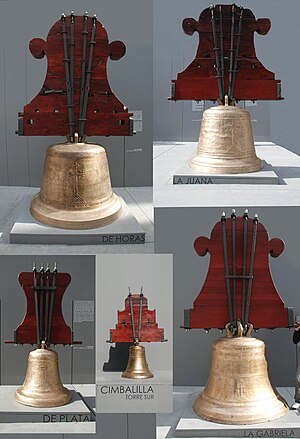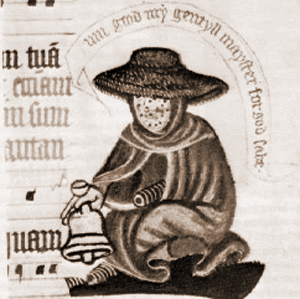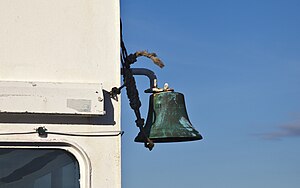Bell (instrument)
A bell is an idiophone percussion instrument, its shape is an inverted and hollowed cup that resonates acoustically and vibrates when struck. The implement used for its operation is generally suspended inside the bell itself, it is vertical and is known by the name of "clapper" or "uvula", made up of a rod called a cane and ending in a ball that is the one that hits the bell. instrument. A mallet or electric hammer can also be used for its operation, or in small bells a small loose sphere enclosed within the body of the same.
Bells are generally made of cast metal, mostly bronze, but there are small decorative bells made of ceramic or glass. These range in size from small clothing accessories to temple bells over 5 meters high, weighing many tons. Historically, bells are associated with religious rituals, therefore they have been widely used to call the community (believers or not) to religious and secular events. Later, the bells were made to commemorate important events or people and have been associated with the concepts of peace and freedom. The study of bells is known as "campanology."
Religion and bells
On Christianity and its temples
In the western world, its most classic form is that of an inverted goblet or that of a bell that is placed inside a tower or belfry, and is sounded through a string attached to the clapper and that pulls it, hitting thus the body of the bell. A set of bells, hung in a metal circle, of different sizes and tones, is known as a carillon (chime in English). Currently the functions of the bells are liturgical and hourly, there are bells for liturgical use as well as for a tower clock; the carillon is responsible for interpreting various melodies, either mechanically by a computer or manually by a carillonist. The current mechanisms used consist of swinging (oscillating movement of the bell, which makes the clapper move at the same rate, hitting the instrument and producing a binary sound), turning (which is the complete turn of the bell, with a yoke that has lead counterweights or other material to facilitate movement and that produces a tertiary sound) and manual ringing (in which the bell is fixed and is manually played through the movement of the clapper with a string); these ways of ringing the bell can be: manually by a bell ringer or electrically through motors, draft motors, electric hammers and computers.
In the Eastern world, the traditional forms of temple and palace bells are rung through a strong blow with a rod or stick, the small ones, and the larger ones with an external blow by a large beam, also known as ram. This astonishing technique is employed throughout the Eastern world by some of the greatest bell ringers, to prevent swinging bells from damaging the towers.
In the Catholic Church and among some Lutherans and Anglicans, small hand bells, called sanctus or mass bells, are rung at mass when the priest raises aloft the sacred species, first the host and then the chalice immediately after he has said the words of consecration over them (see Consecration). This serves to indicate to the assembly that the bread and wine have just been transformed into the body and blood of Christ (see Transubstantiation), or, in the alternative Reformation teaching, that Christ is bodily present in the species, but that these continue to be bread and wine, thus coexisting his body and blood with bread and wine (see Consubstantiation).
In the Russian Orthodox Church, the bells do not move when rung, only the clapper moves. In each bell tower, a complex system of special ropes is used and developed individually. Some strings (smaller ones) are held by hand, larger strings are held by foot.
In Japanese religion
Bells are also used in Japanese, Shinto, and Buddhist religious ceremonies. Suzu, a homophone meaning 'refreshing', are spherical bells containing metal pellets that produce sound from within. The hemispherical bell is the kane bell, which is struck externally.
In Buddhism and Hinduism
Hindu and Buddhist bells, called ghanta in Sanskrit, are used in religious ceremonies. A bell hangs at the door of many Hindu temples and is rung when worshipers enter the temple.
Bells interpreted as a cause of war
On January 15, 1602 (Keicho 7), a fire broke out at Hoko-ji, a Buddhist temple complex in Kyoto. The great Buddha image and the structure that supported the statue, the Daibutsu-den, were engulfed in flames.
In 1610, Toyotomi Hideyori decided to sponsor the reconstruction of Hoko-ji and also ordered the construction of a large bell cast in bronze.
On August 24, 1614 (Keicho 19), the huge new bronze bell was successfully manufactured. The opening ceremony was scheduled, but unexpectedly, Tokugawa Ieyasu prohibited the ceremony from taking place because he interpreted the inscriptions on the bell as a personal affront:
The tablet on the Daibatsu-den and the bell with the inscription "Kokka Anko" (which means ‘the country and the house, peace and tranquillity’), were the elements by which Tokugawa Ieyasu felt offended, claiming that he was conceived as a curse on the part of the del character (a curse).an, ‘peace’) that had been placed between the two characters that compose their own name ((ka-ko, ‘tranquility house’) (subtly suggesting that perhaps peace could only be reached through the dismemberment of Ieyasu?)... This incident in the inscription was, of course, a mere pretext, but Ieyasu realized that he could not enjoy the power he had usurped in the time lived by Hideyori, and therefore, although the latter more than once sent his kerei Katagiri Kastumoto to Sunpu Castle with deep apologies, Ieyasu refused to accept them.
This controversial dispute led to the Siege of Osaka (大坂 の役 Ōsaka no Eki?, or, more commonly, 大坂 の陣 Ōsaka no Jin), which consisted of a series of battles between troops of the Tokugawa shogunate and the clan's samurai Toyotomi. The siege lasted until 1615. Conventionally it was divided into two stages: the winter campaign and the summer campaign. Ultimately, the total destruction of the Toyotomi eliminated the last opposing shogunate clan that would come to dominate Japan for the next 250 years.
Manufacturing
The casting process for bells dates back to the 4th or 5th century in Europe. The traditional metal for bells is bronze of approximately 22% tin and 78% copper. Known as bell metal, this alloy is also traditional for the best Turkish and Chinese dishes. Other materials are sometimes used to alloy large bronze and iron bells. Steel was used in temples in England in the mid-19th century century, due to its economy relative to bronze, but casting in this metal it was not durable and its manufacture ceased in the 1870s.
Foundry
Small bells were originally made using the lost-wax process, but large bells were cast upside down, in a two-part mold attached to the base of a plate. The core is built on the base of the plate with porous materials, such as coke or brick, and covered with mud well mixed with straw and horse manure. This gives it a profile corresponding to the inside shape of the hood finish, and it dries with gentle heat. Graphite and chalk are applied to finally obtain a smooth surface. The exterior of the mold is made within a perforated cast iron box, larger than the bell finish, and containing the clay mixture which is shaped, dried and smoothed in the same manner as the core. The wrap is inverted (face down), placed over the core, and attached to the base plate. The clamped mold is generally supported by being buried in a mold pit that supports the weight of the metal and allows for uniform cooling. In early times, before road transport of large bells was possible, a pit could be dug on a building site where the new bell would be installed. Molten bell metal is poured into the mold through a box lined with foundry sand.
Tuning
The bells are made with exact formulas, so, given the diameter, it is possible to calculate all the dimensions and its musical note, or pitch. The note frequency of a bell varies with the square of its thickness, and inversely with its diameter. Many experiments have gone into determining the exact shape that will give you the best tone. The thickness of a bell at its thickest part, called the "foot," is usually one-thirteenth of its diameter. If the bell is mounted as a mould, it is called a "single bell". "Tuned Bells" are worked after they are cast to produce a precise note. The sound elements of a bell are divided into hum (see subharmonic), second partial, third, fifth, and nominal/named note. The loudest pitches of the bells are set to octave intervals below the nominal note, but the other notes must be in the correct relationship. Bells are usually tuned by tuning forks and electronic strobes, mostly using devices called strobe tuners.
History
The bells, already known to the Egyptian and Asian peoples in the form of bells and also used by the Greeks and Romans, were adopted by the Catholic Church to summon the faithful at least since the fifth century. The Romans gave them the name tintinábula and the Christians called them signum because they served to signal or notify the time of meetings. But already in the seventh century, if not before, they were called "bells", as recorded by writers of the time. In those first centuries, they must have been small-sized bells, it seems from those that have come down to us and from certain references from historians. But they gradually increased in size until in the XIII century they were cast in large dimensions, truly colossal since the XVI. The raw material of the bells has almost always been bronze, although admitting different alloys according to the times and nations. Iron has also been used and for bells, gold and silver.
As for the shape, the following can be distinguished:
- The square prevailed for the Irish of the oldest era.
- The forecloth and foreground was given for those of the Latin region in the early Middle Ages.
- The same but more elongated and sometimes semi-void form, for those of the Romanesque period (siglos XI and XIII).
- Since the 13th century they acquire more widening in the mouth as a trumpet.
- Since the 16th century they take the curved and elegant form it now has.
Since ancient times, the bells usually have some embossed inscriptions on the external surface, made in the foundry and when they are blessed they are given a name, which is sometimes inscribed on the piece itself.
The texts of the inscriptions have varied over time, starting from an early period up to the XII century approximately, in for which what is relevant is the origin of the bell: a pious donation, by order of the person who was cast, etc. As of this date, prayers and sacred texts with a protective meaning are introduced, such as «Mentem sanctam spontaneousam voluntatem honorem deo et patria liberacionem», in addition to those indicating ownership or origin. These texts are justified by a triple function of the non-musical bell: liturgical object, protective object and object of social representation.
Apart from the temple bells, which are used to call the trades, announce deaths or for the hour of Angelus, there is the altar bell, which is usually played by the acolyte at the moment of the elevation, during the mass.
As a military instrument, in the Middle Ages the retinue would gather to its sound to march in host to the algaras or cavalcades. In the XVII century, when a square was taken, the master or superior commander of the artillery had the privilege of appropriating the bells that Ordinarily rescued the population has risen in price, sometimes using the amount thus obtained to pay pensions of widows and orphans of artillerymen. At the siege of Danzig, Napoleon I revived this custom and the value of the bells was distributed among the victorious artillery.
The oldest bells of Christian origin known today appear to be:
- Some Irish iron (campanillas), especially St. Patrick’s (sixteenth century) at the Dublin Museum.
- One bronze in Noyon of the CenturyVII.
- Other bronze, also from Ireland and the centuryXV.
- La Wamba of the Cathedral of Oviedo with founding date of 1219 and currently in use.
- The Spanish votive of the Abbot Sansón of the Museum of Cordoba, which has the form of a great dedal with asa and carries an inscription of the year 955 or 925.
Related expressions
- "Put the bells on the flight." Giving publicity with joy to something.
- "Hear bells and not know where." Having a vague and confusing knowledge of things.
Notable bells
- Campana de Dolores, bell with which the call of rebellion was made against the authorities of the Viceroy of New Spain. The herring, known as "Grito de Dolores", was made by Miguel Hidalgo and Costilla, an independentist hero of Mexico.
- Tsar Kolokol, the largest bell in the world, now without use for its breakage.
- In the tower of the Basilica of San Pascual de Villarreal there is a bell of 1250 kilos.
- In the Basilica of the Pilar is the bell the PilaraMore than 2170 kilos.
- In the Cathedral of Santa María la Real de Pamplona you will find the bell Marythe largest in use in Spain, of more than 10 tons. It is also there the Gabriela, the largest volt bell in the state, of more than 2400 kilos.
- Champion of Freedom, the bell with which the citizens of Philadelphia were summoned to read the Declaration of Independence of the United States of America, becoming one of the symbols of the freedom of the United States.
- Big Ben, bell located in the Elizabeth Tower (Torre de Isabel), which houses the world's largest four-sided clock.








